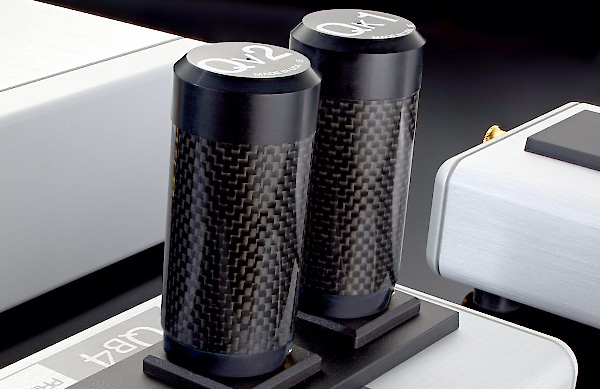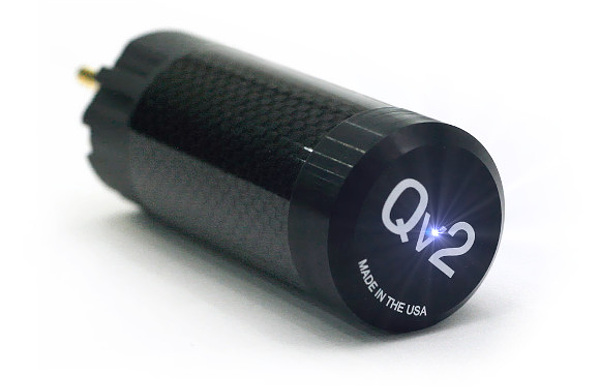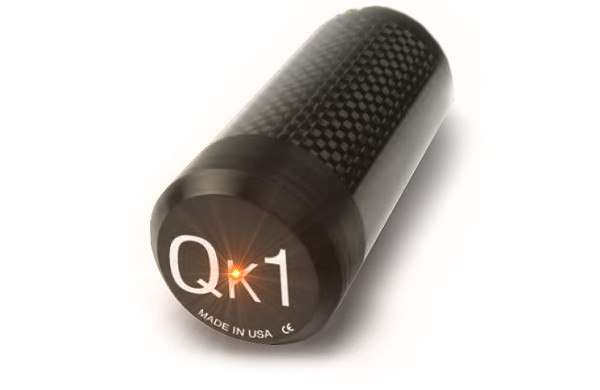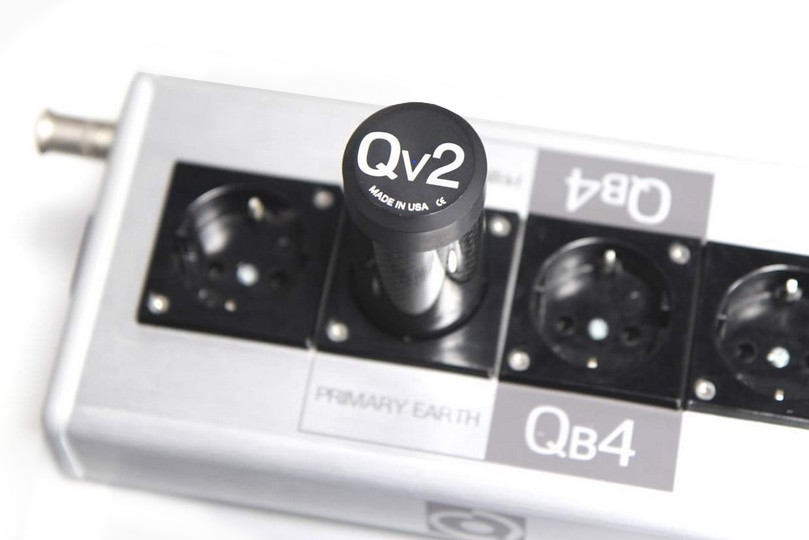NORDOST Qk1 and Qv2
Power conditioners
In my scribbled notes I found many expressions like “a bit, almost unnoticeably, perhaps, ever so slightly”. This leads to a logical conclusion that removing the Qv2s from the system should be almost unnoticeable, with perhaps a bit less accomplished sound that will be just slightly inferior to Qv2-powered system. Oops! Not at all. The moment the Qv2s were unplugged the music became stressed, mechanically rushed and confused. The music lost its flow and it lost its life.
Funkce a forma
Most audio components are easy to categorize. With speakers and electronics reviewers make verdicts pretty easily and very rarely these are revised – there is no need for this as the component is replaced by an upgraded model in the endless innovation cycle. But there are components, like cables, that can only be evaluated in the context of existing system. Change the system and the result varies. As our audio gear is improving we can hear more, ditto holds true for us, listeners and reviewers, we become more mature and pickier too. So after long 7 years it goes full circle and I have in my hands Nordost´s QRT (Quantum Resonant Technology) AC line conditioners again. Yes, that´s how long the Qk1 and Qv2 have been on the market without any upgrade, which is quite unusual even for an ´accessory´.
To be honest, with all the Qk1s and the Qv2s I also got Nordost´s brand new QPoint harmonizer for the review. I found that it was the QPoint which made the biggest impact on how my system sounded, but I also found that these changes were not in the direction of ´higher fidelity´. I can´t recommend the QPoint to classical and jazz music lovers if you cherish authenticity, but I would wholeheartedly recommend it to anyone into rock or pop where it injects unbelievable shot of energy.
The Qk1 and Qv2 plug-in modules were conceived with a goal to make any already accomplished high-end system sound from good to great. Both the devices have beautifully finished Furutech-style carbon housings and look like any other high-end power cord, only that the cord is missing.
The device is supposed to be plugged in the same AC circuit like the rest of electronics. The effect should multiply with the number of additional QRT devices plugged in. Nordost recommends to use the modules in pairs for the best result. All the Qk1s and Qv2s had several hundred hours on them so I skipped burning in period, yet I let them warm up for few minutes before each auditioning. The housing of the Qv2 gets quite warm, the Qk1 stays pretty cool.
The Nordost Qkoil aka Qk1 is officially an “AC Enhancer”. According to the manufacturer it should improve overtones and pacing of the music, and delivering greater sharpness, depth and focus to visual qualities in audiovisual systems. Technically it is a coil wound with Nordost’s proprietary micro-mono-filament wire that also the company’s Reference range employs and that a user inserts in parallel with the AC line which feeds the audio equipment. The connecting parts of its Schuko plug are gold plated, the working status is indicated by a tiny red light in the cap. Seven years ago I described the Qk1’s sound by these words:
“The change in sound was very subtle, if any. I felt – rather than heard - that cymbal crashes on I Want to Tell You ‘Bout That (Stanley Clark, McCoy Tyner, Al Foster, Telarc Jazz, SACD) were more delineated and that the pondering bass had a “slightly different” quality, not sure what the different quality was. By repeating the same exercise – Qk1s in and Qk1s out – I had to finally give up by not being able to tell reliably apart when the devices were on and when off. I achieved better results with the Van Medevoort PAQ power amplifier with its slightly tilted up upper midrange that either due to its clarity or higher AC sensitivity indeed benefited from the addition of the two Qk1s. The same subtle effect of better delineated transients and fuller bass was now more profound with the two QK1s plugged in the Nordost Thor. Still, the change in the sound was smaller than swapping two powercords.”
The Nordost Qvibe aka Qv2 is a unit that is close to Quantum’s philosophy of “harmonizing” an audio system, whatever it means. It should improve the sense of space, color, presence and life to an audio system. In result, the sound should be more natural, more lifelike. Like with the Qk1 also the Qv2’s Schuko mechanism is gold plated and its working status is indicated by a bright blue LED. My notes from 7 years ago read:
“It was not until 2 Qv2s were plugged in parallel to the main AC line when I heard more significant difference. Surprisingly the highs did not get cleaner or more extended – it was the bottom end that benefited the most. The bass guitar around 4’ mark got more legible with Qv2s in place, more discernible from surrounding ambience. Yet, the most convincing result arrived with the Qv2s plugged in the power distributor. I was consistently getting more dynamic leading edges of attacks and longer decays.
On vocals, listening to Katie Melua’s Crawling Up a Hill (Call off the Search, Dramatico), I heard a little bit less of the digital edge and a little bit more of analog liquidity. Mozart’s Allegro Maestoso performed on solely percussive instruments by the All Star Percussion Ensemble (Super HDCD 24bit, FIMCD 017) did not lack anything from its big dynamic contrasts, quite opposite, it further bloomed showing more vivid colors and more relaxed sound. Precious (Depeche Mode, Playing The Angel, Mute SACD) benefited too and the guitar line around 2’45” mark became more palpable and Dave Gahan’s voice a tad bit more three-dimensional.
Since my time with the Nordost´s modules my system has evolutionary developed and it has now quite a number of unused power inlets which are begging for being occupied. After my recent and completely positive experience with similarly conceived Ansuz Sparkz TC2 plug-in devices I decided to re-check what the Nordost Qk1 and Qv2 may offer in 2020.
Nízké frekvence
It really pleased me that my historical evaluation of the Nordost’s QRT units holds true even today. Yet, mainly to largely improved acoustics in my reference listening room which does not obscure the recorded information a bit, I hear the effects of the Qk1s and Qv2s much more clearly and unambiguously.
I had four Qv2 and two Qk1 modules on hand so I had to make a strategic plan how to explore all the possible placement options in the total of 11 power outlets available in my grid. There was several dozens of combinations possible and there was a simple option of reversing phase of the module which doubles the total count. To start I decided to take just one Qk1 (or Qv2 respectively) and plug it in outlet by outlet to identify where I would hear the biggest contribution or detrimental effect. This only takes couple of hours and then I can take it further from there. Soon my notebook was filled with pencil-scribbled notes that read more vivid colors, better separation, larger soundstage, more air, improved microdynamics, sweeter highs, tighter bass, nicer articulation, and similar. But – with some configurations – it also read veiled, congested, soundstage vertically collapsed, or thin tonality. From this one can deduct that it really matters where the modules are plugged in. At the end of the day it was clear where the single Qk1 or the single Qv2 made the biggest contribution and where they failed completely. Now it was time to add more modules. By doing so I found that the previously created list of the best positions can be completely discarded.
I bumped into the same issue like with the earlier reviewed Ansuz Sparkz TC2 – it was not possible to presume how the Nordost modules would behave once combined or multiplied. It happened that while one Qv2 was plugged in the best performing outlet and another Qv2 was plugged in the second best performing outlet, the result was not additive and the sound degraded. Similarly, if the other Qv2 was replugged to the worst outlet (as identified by preceding procedure) the sound improved. There is no other way then really test all the possible combination to be sure that nothing was neglected. Why do I put so much stress on it? Many audio enthusiast are not patient enough, they just use the module, plug it somewhere and dismiss it saying ‘it’s not for me’. But it does not work like this, unlike you really have only one or two free outlets in the AC grid.
Čistota rozlišení
Before I make you bored, fast forward by 10 days; now the QRT modules found their optimum positions within the power system. With the Qv2s in place I could hear the recorded ambience much better. Like that of Dvorak’s Hall of Prague’s Rudolfinum concert hall in Karel Ancerl’s Pictures from Exhibition recorded in 1968 for Supraphon. The Qv2s transported me to the best seat in the hall and when I unplugged them I completely lost this magic, the soundstage became uninvolving and flatter. The blazing winds that represent the arguing Jews in Samuel Goldberg and Schmuyle picture were absolutely lifelike with the Qv2s plugged in. Though the width and depth of stage became better defined it was its vertical dimension which improved hugely. The violins on the left and the double basses on the right dropped closer to the floor, exactly as they should, and trumpets came over them from further away of the soundstage. The absolute height of the scene did not change but how the instruments were related to each other within it was breathtakingly improved. Also the scale and colors were better with the Qv2s, as were small details. In Bydlo, the heavy-handed double basses got incredible physical presence in the room, with correct ratios between attack, fundamentals, and aliquots. The double bass section was not a section any longer and I could count the bassists and follow their techniques. The same thing is easily heard in choirs and lamentations – there the choirs are becoming members with lots of individualism.
The Qv2s were also able to illuminate the things at the very back of the soundstage, like a rolling snare or a marimba. Not that they brought them forward like some cables and DACs do. The instrument remained at its remote position, proportionally softer in sound, but it was much more clearly delineated and its sound was made distinct within the other orchestration. As much as this soundstaging precision is attractive in sparsely arranged chamber and jazz numbers, it lends a completely new level of organization to symphonies. With the Qv2s I could see deeper into the music. The images became very tangible and though I tempted to use the word “transparent” I will not – what I was hearing was not transparency rather some sort of incredible thereness.
Tonální věrnost
I did not have to play music to hear the effect of the Qv2. My copy of Sheffield Lab’s test CD is the single most played CD I have. The correlated and uncorrelated pink noise tracks became smoothly monolithic with the Qv2 in place, as if the module removed small jittery peaks and dips. It was like listening to a huge waterfall and the Qv2 both zoomed in on its subtle textures and smoothened the system’s response. I played the track #5, Michael Ruff’s Wishing Well, and – for the first time in my long audiophile life – I noticed extremely subtle sounds of strings being released from the guitar’s neck in the first minute of the track. It is a faint resonant rustling, now heard so much clearer despite the band is going full throttle.
Similarly Nat King Cole’s The Very Thought of You (Analogue Productions, SACD) came to life in my listening room. The players in the supporting band became more distinct, there was better separation both between its sections and within the sections, the strings became completely otherworldly and the voice gained extra articulation. Note that this 1958 recording is among the best ever laid on a tape.
In my scribbled notes I found many expressions like “a bit, almost unnoticeably, perhaps, ever so slightly”. This leads to a logical conclusion that removing the Qv2s from the system should be almost unnoticeable, with perhaps a bit less accomplished sound that will be just slightly inferior to Qv2-powered system. Oops! Not at all. The moment the Qv2s were unplugged the music became stressed, mechanically rushed and confused. The music lost its flow and it lost the life.
I returned to Nat King Cole. Without the Qv2 the vocal seemed to be more powerful and more present in the room, as if projected in front of the band. I liked this. What I did not like was the diminished view of what the band was doing, the spatial images got slightly fuzzier and the colors became paler. Many steps back, with the Cole’s voice forward power perceived as a single plus. But really?
This is a nice example of easily the ears can be fooled once the reference point is changed. The band was the reference point. Without the Qv2 it was largely invisible, just an accompanying band to the Cole’s amazing vocal. With the Qv2 it became an equal partner and its playing was not less beautiful and present than the voice. Thus the voice became better integrated with the rest, not singled out. I went back and forth several times and found that the voice’s powerfulness and tangibility was equal in both instances, and it was a bit more articulated with the Qv2 than without it.
Prostorovost
The Nordost Qk1 and Qv2 are ying and yang devices. Each different, yet complementary. The Qv2 can be summarized as wholeness, naturalness, separation, imaging, colorfulness, smoothness and fluidity. The bass was more melodic, the sound thicker and more detailed at the same time. The Qk1 works on the opposite side of spectrum, like an illuminator, bringer of clarity and a rhythmic driver. The soundstage is lifted up, the sound is more present and urgent, and everything is clearer and faster. In the Korngold’s Violin Concerto (Vilde Frang on violin) there was a kind of „zzzing“ factor with the Qk1. I heard a bigger accent on the bow and strings rather than on wooden resonances of the violin’s body. That’s probably why Nordost recommends combine both module to achieve right balance. Still, there is the aforementioned Qpoint that somewhat combines what the Qk1 and Qv2 do, yet it takes a different approach.
Like in my Ansuz Sparkz TC2 review I want to highlight that the Audiodrom’s 100% rating means that the Nordost Qk1 and Qv2 can work magic, depending on how you use them. Therefore I encourage you to test them for yourself, only then you’ll be able to say whether they deserve full 100% score in your system. To my ears they do – I see either of them as an outstanding accessory, maybe the best in the decade.
Prices: Nordost Qk1 250€ / Nordost Qv2 330€ / Nordost QPoint 690€
Doporučení prodejci
Perfect Sound Group, Praha, tel. +420 722 960 690
Web výrobce: http://www.nordost.com
Připojené komponenty
- Sources: Accuphase DP-78, Accuphase DP-720, Luxman D-03X
- Amplifiers: Accuphase A-70, Accuphase C-2410, Van Medevoort PAQ/CAQ/PSQ, TAD M-2500, Luxman L-550AX Mark II
- Interconnects and speaker cables: Cardas Clear, Audioquest Redwood, AudioQuest Dragon Bass | Zero, TARA Labs RSC Air 1EX, Tara Labs ISM The 2EX, Krautwire Numeric, Krautwire MAX-S, Krautwire Fractal, Ansuz Signalz C2
- Loudspeakers: Bowers & Wilkins 802 Diamond, TAD Evolution One E1, Opera Callas Diva, Sonus Faber Gravis I
- Power conditioning: Nordost Valhalla, Block Audio Snakeblock, Nordost Thor (modifikace), Shunyata Research Denali, Synergistic Research Atmosphere Level 2, Supra LoRad, Gigawatt Powerprime, Stromtank S 1000, Stromtank S 2500 Quantum
ACCUPHASE PS-510
The simple fact it actively compensates for the AC power fluctuations does not mean that the device generates absolutely clean power – just try and change the power cord that comes with the PS-510 to some other and you will experience ...
Doporučení prodejci
Nisel SK, Bratislava, tel. +421 905 203 078
ANSUZ MAINZ8 D2 + MAINZ D2
The Ansuz Mainz8 D2 is not a filtration device. It does not have any voltage regulation or oversized transformers inside, rather it relies on several smart technologies that should distribute the voltage, as pure as possible, to your ...
Doporučení prodejci
RP Audio, Ostrava, +420 737 366 831
ANSUZ Sparkz TC2
With three Sparkz TC2 units plugged into the power conditioner the blacks became nano-blacks as if all electric noise that existed within the system had vanished and this exposed the recorded sounds. The downside of it was that the ...
Doporučení prodejci
RP Audio, Ostrava, +420 737 366 831
BLOCK AUDIO Dogblock
The philosophy of the Dogblock is simple: the power distributor gets inspired by the good designs that already exist on the market, improves on them technically and adds amazingly precise craftsmanship. Everything is effective and ...
Doporučení prodejci
Audiostudio s.r.o., Olomouc, tel. +420 608 752 475
FURUTECH Daytona 303E
The Daytona inherits its name from a Daytona GT racing car so you can expect a lot of horsepower under its hood. And it is, indeed. The internal circuitry of the unit provides a user with generous surge protection and advanced ...
Doporučení prodejci
Audiostudio s.r.o., Olomouc, tel. +420 608 752 475
GIGAWATT PC-4 EVO
The GigaWatt’s PC-4 EVO represents the state-of-the art of power conditioners. It is more effective than any other filtering device that I have come across since I reviewed Accuphase’s PS-500 back in 1996 - that is in the last ...
GIGAWATT PF-2
The PF-2 represents the highest model passive power strip in GigaWatt´s portfolioas more sophisticated units are regular power conditioners. In my point of view Adam Szubert found nice balance between overall built and functionality ...







